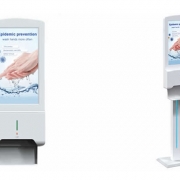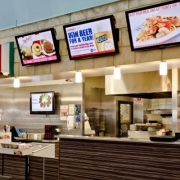Digital menu board vs. traditional- which is best for your restaurant?
It can be a challenge to determine if tech-focused upgrades are necessary for restaurants, which is why it’s important to pinpoint key differences and benefits between digital and traditional solution.
Restaurant signage serves a greater purpose than merely listing item variety; in fact, a high brightness lcd digital menu board can also define brand identity.
Upon entering eateries or fast-food establishments, posted menu boards are typically the first to capture a customer’s attention. Because of this, it’s important for businesses to capitalize on this and truly consider how and what they want to be displayed.
On average, 8 out of 10 passerbys will enter a retail space due to persuasive signage, so in order to remain competitive your visual appeal must stand apart from the rest. With debates between whether or not digital menu boards are more influential than their non-digitized counterparts, considering the right choice for your brand can prove to be a challenge.
To gain a deeper understanding, let’s explore the key differences between traditional and digital menu boards, and whether or not making the switch is right for your brand.
Digital menu boards are a collection of monitors that are run by a central computer. Many restaurants have switched to digital menu boards for their modern and sleek appearance. Digital signage displays on screens of any size, and informs through a variety of channels like video content, animation, and text.
There are several advantages that digital menu boards give business owners over traditional menu boards-
Easier for customers to read by using bright screens and larger text
Updating the menu is simple and streamlined
Saves on printing costs
Reduces labor costs
Higher customer engagement
Provides variety, as screens can automatically change menus throughout the day
Traditional Menu Boards Traditional or static menu boards are still useful to many restaurants. Static signage has two functions- to inform and to decorate.
These menu boards are easier to install and have a lower price range than digital boards. Some restaurant owners may want to maintain a certain ambiance, so in order to remain consistent with the decor, like 50’s themed diner, for example, a digital sign may not be the best fit. Benefits of traditional menu boards include-
No digital errors
No digital operating costs
Longevity
Uniqueness of design
Digital vs. Traditional Menu Boards
Digital and static menu boards are both informative; however recently, high brightness digital menu boards have created a game-changing strategy of brand recognition and customer engagement that makes it difficult for static menu boards to compete with.
Here are the key differences between both forms of signage.
1. Cost
Traditional menu boards must account for costly printing costs to create all visual materials, whereas digital boards do not. Instead of having to reprint updated menus, digitized menu changes can quickly and simply be applied to a digital sign over the computer.
Not only do digital menu boards cut down on materials costs, but it also reduces food costs and waste. Digital menu boards sync with POS, point of sale, systems, allowing employees to more accurately track inventory. This is widely beneficial when taking food expiration into account, or monitor when ingredients or menu items or running low.
With clearer insight on inventory, businesses prevent waste. This is accomplished by achieving a higher sales margin per transaction because sales opportunities are not being missed out on due to menu items running out of stock.
Digital menu boards also save money in the long term when looking at economies of scale. Economies of scale are cost reductions that happen when companies increase production. Depending on the restaurant and its seasonality, menu boards may require five to six updates or revisions annually.
2. Customer Experience
In today’s fast-paced world, customers expect quality and speed; technology makes that possible. By upgrading a menu board to a digital experience, customers are more inclined to visit. By using bright screens with clear text this allows for easier readability. Surveys show that 74 percent of customers’ top priorities is an easy to read menu.
Digital menus can also entertain consumers. While waiting in line, customers can be engaged with content on the screens, distracting from the wait time.
Digital menu boards have the ability to up-sell to customers, boosting overall sales. Upselling is when a seller influences a customer to buy more expensive items or add-ons to make a more profitable sale. Instead of an employee suggesting any up-sells, the menu board can suggest up-sells, and the customer may subconsciously up-sell themselves without any feeling of pressure from an employee.
3. Scheudling and Updating
Employers can set a digital menu board to automatically change menus at a specific time of day. The need for physically switching out lunch menus with dinner menus is eliminated.
Also, adding new menu items or changing prices can now be done remotely. Management can use smartphones, or any device with internet access to add or change information instantly. Digital menu boards can also be quickly updated to comply with new or upcoming health laws.
For example, per the Affordable Care Act, the Title IV Law states- “restaurants and similar’ retail food establishments that are part of a chain with 20 or more locations doing business under the same name’ to disclose in a clear and conspicuous manner’ a nutrition disclosure statement,’ a suggested daily calorie intake,’ and the number of calories contained in the standard menu item.’ Standard menu items do not include such things as daily specials, but they do apply to food on display’ and self-service food.'”
By using a digital menu board, inputting this information is nearly hassle-free and allows for the restaurant to stay current and compliant. This also aids in keeping consumers informed on calorie intake, promoting a health-conscious mindset.
4. Management
As a restaurant chain grows larger, it can be more difficult to maintain consistency in appearance and operational practices across multiple locations. With traditional menu boards, there is no guarantee that all locations’ menus are uniform in appearance.
Digital menu boards take away the uncertainty through the ability to collectively update all menus at once. This eliminates menu discrepancies and creates a fluid branding image and marketing strategy. Centralized control can also eliminate errors and inefficiencies. Employers can monitor screens and control content and messaging from almost anywhere, as long as there’s an internet connection.
5. Enviromental Impact
An estimated 18 million acres of forest are eliminated due to deforestation, of which is contributed to 40% of paper products. This includes catalog and glossy paper, materials often used for menus, and posted menu signage.
Digital boards cut the need for printing new messages and can be easily changed and updated. Digital menu signage eliminates the need for paper menus, which lessens a company’s environmental footprint and increases profits by getting rid of printing costs. It’s important to note that digital menu boards’ use of electricity also have environmental impacts, but it is much smaller in comparison.
LCD technology makes digital menus a more viable option that is also eco-friendly because it requires low energy consumption in comparison to other lighting sources. By requiring less power, LCD technology reduces greenhouse emissions from power plants.
6. Hours of Operation
Unlike static menu boards, digital menu boards can continue to advertise its products after store hours. By having a brightly lit screen this takes the restaurant outside and can share its brand to future customers walking past the restaurant. Employers can set an evening schedule through digital signage software to tailor messages for after hours.
7. Visuals
Digital signage catches the attention of customers and can influence their purchasing decisions by creating an intimate one-on-one interaction. Digital menu boards can also focus on deals or promotions that increase overall sales. With access to video content or automated GIFS, this adds an element of motion to a menu board and can capture a customer’s attention faster. However digital boards can deter customers by too much activity. Crowded boards with too much information or text can actually make it difficult for customers to pay attention to the main message, so it’s important to ensure all content is displayed in a strategic and thoughtful manner.
8. ROI
To compete with continuously changing markets, restaurants have to be as innovative as ever. A digital menu board will practically pay for itself and increase a business’s return on investment. ROI is the ratio between net profits and the cost of investment. By increasing sales margins and maximizing seasonal opportunities, promoting upsell purchases through the digital experience, improving the impact of a brand, and eliminating static menu printing costs this positively affects a company’s ROI.
9. Target Audiences
After seeing a static menu board several times, customers can begin to disengage with content. Digital boards not only show frequently updated content but also employers can easily tailor promotions to their target audience. For example, a restaurant near a high school may have school lunch promotions for students, and this content can be displayed during the time students are out for lunch.
10. Foot Traffic
By using interactive screens it not only increases engagement but also increases efficiency. For example, it’s a worker’s lunch break and he/she is in a hurry. By utilizing a touch screen menu, customers can quickly make selections without any human interaction, and make it back to work on time. This can also turn tables faster and allow for more customers to come in and eat.
11. Community
Gaining the loyalty of local customers can help many restaurants survive amongst the competition. Using digital menu boards, restaurants can show its appreciation by giving back and sharing community news on its screens. For example, it could display local news such as upcoming events, or promote local businesses in the area.
So, What Should You Ultimately Invest In?
Both traditional and digital menu boards have their roles in restaurants. Typically, many restaurants can utilize both in a single business, like using a digital menu board for dine-in customers, while also incorporating static menus for customers who want to take a menu to-go for future pickup orders.
Businesses should invest in digital menu boards because it can increase business efficiency, provide better service to customers, and boosts a company’s bottom line. However, it’s not enough to simply purchase the digital software, mount the displays, and watch the profits unfold. In order to maximize digital menu board benefits, it’s important for a business owner to understand the technology and by having a better understanding of it, use it to his/her advantage.













